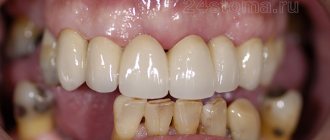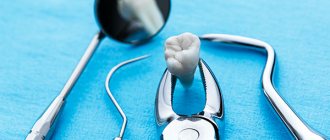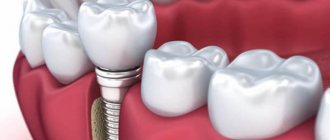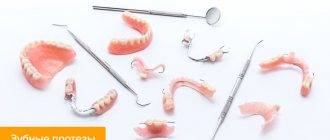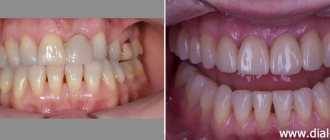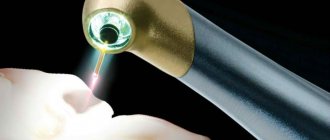Before deciding on dental implantation, patients want to know step by step how dental implants are placed.
The complete implantation procedure includes 3 stages:
- preparatory,
- surgical,
- orthopedic.
We have prepared a detailed description of each of them.
Why implantation?
All methods of dental prosthetics prior to implantation negatively affect the condition of the oral cavity in the future, often causing premature wear and loss of teeth. In particular, the manufacture of bridge-like prostheses - bridges, as they are also called - requires the depulpation and preparation of two, and sometimes three, teeth to replace just one lost tooth.
Such radical treatment, to put it mildly, is not beneficial for the jaw system and leads to overload of the supporting units with further root inflammation and tooth loss. At the same time, the average service life of “bridges” is 6-7 years.
The situation with removable dentures is even more complicated: for any removable device, the support is the gums and bone tissue of the jaw, which, in principle, is not adapted to a full chewing load. As a result, a chronic inflammatory process develops, and the bone atrophies and dissolves.
Types and features of dental implants
There are 6 types of implants:
- intraosseous root-shaped;
- intraosseous in the form of a plate;
- combined - plates with pins;
- subperiosteal, located under the periosteum;
- endodontic, inserted through the root apex.
- Submucosa is injected into the gum and is used to stabilize removable dentures.
The doctor chooses the implant after assessing the condition of the patient’s jaws. Intraosseous implants are the best option; they are used in most cases. The products are strong, durable, and imitate the root well.
Subperiosteal implants are installed when the bone is thinned and damaged. This product is made in the form of a frame, similar to a saddle, which is placed under the gums.
The endodontic type is used if part of the root is preserved. The product helps to lengthen the root and secure a fixed prosthesis. This method is the most gentle, as the implant takes root quickly.
What to prepare for
Dental implantation is a technique that does not have the disadvantages of previous generations of prostheses. Implantologists consider it as the only way to restore lost teeth that does not harm the health of the oral cavity and has an unlimited (usually lifelong) service life.
Important! No other prosthetic method provides such high aesthetics as implantation.
But it should be taken into account that dental implantation is not a simple procedure during which an implant is simply inserted in place of the missing unit. The future tooth (more precisely, its root) must have a certain size, the proper position and direction, and a strictly defined inclination are selected for it.
In addition, it is necessary to restore all the tissue surrounding the tooth - and, first of all, bone tissue and gums. It is this comprehensive approach that allows us to achieve reliability, impeccable aesthetics, and durability of implant treatment.
Implantation is a slow process, except for one-stage implantation, as well as the “all on 4” and “all on 6” techniques. Treatment usually involves several stages, despite the common name of "two-stage" surgery.
Treatment always begins with diagnosis, which is the first and, perhaps, the most important stage that determines its outcome. Based on the results of the preliminary examination, a decision is made on implantation technology, types of implants, and the details of the upcoming operation are thought out.
Important! It is necessary to prepare for the fact that during the implantation process you will have to go through several stages. A standard scheme applies to all patients, so we have prepared a detailed description of each stage of dental implantation.
Dental implantation under anesthesia
Today, dental implantation is always performed under anesthesia. Local anesthesia is used and in some cases, when the operation is long and tedious, sedation is used. In some cases, general anesthesia may be used, but this usually occurs in rare cases where local anesthesia is ineffective.
It is believed that general anesthesia has some negative effects on the body and can worsen the survival rate of implants, so it is rarely used, making do only with local or combined anesthesia and sedation. In any case, the operation is completely painless for the patient and the period of return to normal after anesthesia takes a very short time.
The Dental Master clinic employs experienced, highly qualified implantologists, uses the most modern techniques and equipment, uses implants, components and instruments from the world's leading manufacturers, so implantation here is reliable, safe, effective and very economical.
Stage 1: diagnosis
It may take some time to choose a clinic and an implantologist, since this is one of the key points in the whole story. In addition, you need to get to know the orthopedist and, if necessary, the therapist - these doctors will also take part in the process of implantological treatment. If everything is satisfactory, then before implantation an examination is carried out by a surgeon.
He will tell you whether it is possible in principle to place an implant in this patient, and will develop further treatment tactics based on the following data:
- general oral health;
- the presence and condition of neighboring teeth and gums, which are located next to the future implant root;
- bite;
- hygiene quality;
- financial capabilities of the patient.
The price is usually included in the total cost of treatment, which is carried out in most clinics on a turnkey basis. The doctor will announce the approximate cost, the final price is determined after diagnostic testing and consultation with an orthopedist. If a patient needs the help of a physician, hygienist or periodontist, then their services should be considered.
Diagnostics includes instrumental and laboratory studies, without which surgery is impossible. These examinations are necessary to exclude a number of complications after the introduction of implant rods and achieve extremely good treatment results.
Complications - when should you see a doctor?
If you experience any of the following symptoms, contact your doctor as soon as possible:
- After the 3rd day of surgery, pain gradually increases
. It is quite normal to experience minor pain for the first 2-3 days, but no more. - On the 4th day the swelling began to increase with an increase in body temperature
. Normally, it should subside on the third day. If it grows, then there is a problem. - After 4-5 hours, the surgical wound continues to bleed
. Minor bleeding in the first 2-3 hours is normal. But you should be wary if the wound continues to bleed. - Part of the face became numb, and there were difficulties opening the mouth
. This is due to stretch/compression or injury to the nerve. It occurs very rarely (in less than 3% of patients) and is associated with physician error. - The temperature rose sharply to 39° on the fourth day
. An increase in body temperature to 38° in the first three days after surgery is a completely normal reaction of the body to surgery. But if after three days you notice a sharp increase in temperature, then you need to consult a doctor. - Purulent discharge appeared from the implant site
. This indicates the presence of an inflammatory process due to infection of the hole.
Instrumental studies – tomography and x-ray
They are performed on all patients, regardless of the chosen implantation technology. Based on the data obtained, the issue of the types of implants and the methodology of the implantation operation itself will be decided.
An X-ray is taken selectively, precisely in the part of the jaw where implants are planned to be installed. Using it, the doctor evaluates the condition and location of the roots of the teeth, near which the implant should be installed. The price of such a photo starts from 700 rubles.
A panoramic photograph is needed for any type of prosthetics, and implantation is no exception. Otherwise, it is called an orthopantogram and is performed to take into account the characteristics of the bite and the condition of the bone tissue. All this is of great importance, since a strong foundation is extremely important for the implant root.
The price of a 3D image - orthopantogram - from 1500 rubles.
But the most important study at the diagnostic stage is CT - computed tomography. Without it, not a single dental implantation operation is performed, and neither an X-ray nor an orthopantogram can replace it.
Computed tomography is the most expensive examination at the diagnostic stage, the price of which starts from 3,000 rubles. Based on its results, the quality of bone tissue is assessed, the sites for installing implants and their type are selected. It is the tomogram that allows the implantologist to conclude that bone grafting is necessary if there is insufficient bone volume.
Modern medical centers where implantation operations are performed are equipped with high-precision equipment and use navigation programs. All this makes it possible to plan the course of treatment in detail and even show its future results to the patient!
Stages and deadlines
1. Initial appointment (up to 20 minutes).
The implant surgeon gets to know the patient. Visually examines the oral cavity, assessing the current health of teeth and gums. To exclude the presence of contraindications and analyze the possible risks of complications after implantation, the doctor collects an anamnesis - information about the patient’s living conditions, diseases, bad habits, pharmaceuticals taken, etc. Answers any questions that may arise.
In what cases is it recommended to undergo tests before implantation?
Additional examination is necessary if the patient:
- has a chronic disease;
- undergoing any treatment;
- in the last 1-2 months, suffered from a serious illness or underwent surgery.
2. Comprehensive hardware diagnostics (up to 30 minutes).
Includes:
- Sight shot
. Necessary for assessing the condition of teeth located adjacent to the implant installation site. Detects inflammatory processes at the apex of teeth, hidden fractures/root injuries. Helps assess the quality of installed fillings (if any). Eliminates the risk of infection from neighboring teeth getting into the socket when an artificial root is implanted. - Panoramic photo (orthopantomogram)
. This three-dimensional image allows you to visualize the upper and lower jaws in an expanded plane. OPTG helps the doctor give an initial assessment of the condition of each tooth, its canals and roots, periodontium, maxillary sinuses, sinuses and other structures of the dental system. - CT (computed tomography)
. Allows you to study in detail the required area of the jaw in any plane at the required angle. Reveals hidden inflammatory and pathological processes in the periodontium. Helps to select the optimal dimensions of the titanium rod, as well as the installation location. Eliminates damage to the maxillary/mandibular nerve and blood vessels during implant installation. Provides important information for 3D modeling of the surgical process.
3. Computer modeling (2-3 days).
Three-dimensional visualization allows the implant surgeon to calculate and see the result of treatment before it begins.
The software helps the doctor determine the optimal locations for installing implants, taking into account the density and volume of bone tissue, select a titanium rod model, and calculate the angle and depth of implantation. The human factor is excluded, the result of implantological treatment is calculated with high accuracy. 4. Preparation (sanitation) of the oral cavity.
Before implantation, it is important to carry out professional dental hygiene (cleaning from plaque and tartar), eliminate existing inflammatory foci, and cure dental diseases identified during diagnosis (caries, pulpitis, etc.).
Jaw implantation using All-on-4 or All-on-6 technology also requires the preliminary removal of existing teeth, since a complete fixed prosthesis of 12 or 14 crowns is installed.
5. Osteoplasty.
If there is insufficient bone tissue volume, before installing a titanium rod, one of the following methods is used to build it up:
- Alveolar ridge clefting
. The doctor makes a cut into the alveolar process (the part of the jaw into which titanium screws are implanted) and increases its thickness using artificial bone material or graft. Installation of the implant is possible after 4-6 months. - Guided bone regeneration
. During the operation, the doctor places a synthetic bone analogue into the jawbone and covers it with a protective membrane. The patient's blood plasma is used to stimulate bone tissue growth. Implantation is possible in 3-6 months. - Sinus lift
. The volume of bone tissue in the area of the maxillary sinuses increases. There are open (more extensive surgery used for severe bone atrophy) and closed sinus lift (less invasive, with a slight lack of bone height).
Our clinic uses Straumann Roxolid implants, which allow us to avoid bone grafting in 95% of clinical situations, both when restoring one tooth and during total prosthetics of a toothless jaw!
6. Surgery (15 minutes).
Under local anesthesia, the doctor makes an incision in the gum and lifts flaps to gain access to the jawbone.
Then he prepares the implantation bed by drilling a hole of the required depth in the bone. After checking the depth of the canal with special tools, the implantologist bores it to the required width.
A titanium rod is implanted into the resulting hole. Its model, length and thickness are selected at the 3D modeling stage.
The implant is closed for 2-6 days with a plug, which protects the artificial root from microbes and mechanical influences.
The gum is sutured, closing the temporary plug.
On days 3-7 after implantation, the sutures are removed and an abutment is installed.
7. Orthopedics.
It takes place in two stages. At the first visit, an impression is taken within 20-30 minutes, on the basis of which a temporary crown will be made in the dental laboratory. At the second visit (after 2-3 weeks, depending on the clinical picture), the prosthesis is fixed to the abutment (duration - up to half an hour).
Lab tests
The diagnostic stage before implantation necessarily includes a general and detailed blood test. This is a must for everyone. Certain categories of patients will need to provide the results of hormone tests (usually women) and other specific laboratory tests if there are concomitant pathologies.
A number of diseases are a relative contraindication for surgery to install implants, and then a preliminary consultation with a specialist is necessary. If necessary, before implantation, the condition is corrected to acceptable levels (for example, in the case of diabetes).
The price of sample collection services may vary and depends not only on the number of studies. Many tests are done in district clinics, and will be free if referred by a doctor. Thanks to this approach, diagnostic costs can be significantly reduced.
At the diagnostic stage, all patient data is collected, and based on the information obtained, the optimal method of dental implantation and type of implants are selected. After agreeing on the finished plan with the client, we begin to implement it. Next begins the stage of preparation for the implantation operation.
Contraindications
Dental implantation is a complex surgical operation that has a wide range of contraindications, both absolute and relative.
The procedure is completely contraindicated in the following cases:
- with severe mental disorders;
- for cancer of any origin;
- if a blood clotting disorder is detected;
- for severe autoimmune and rheumatic pathologies;
- for tuberculosis;
- for diabetes mellitus;
- for osteoporosis.
Relative contraindications include conditions that must first be cured, and only then think about surgery:
- caries;
- gingivitis, stomatitis;
- periodontitis;
- hormonal imbalance can cause pin rejection;
- pregnancy period;
- breastfeeding period;
- childhood;
- smoking, alcoholism and drug addiction;
- anorexia;
- insufficient oral hygiene;
- acute respiratory diseases;
- rehabilitation after injuries, operations, radiation therapy.
After eliminating the relative contraindication, implantation can be performed on the recommendation of the dentist.
Stage 2: preparatory
Details of the preparatory stage may vary significantly for different patients due to differences in the condition of the oral cavity in general and the jaw bone tissue in particular. Most people planning to have implants require dental hygiene.
Sanitation is carried out with the aim of eliminating bacterial plaque from the surface of tooth enamel, since a successful implantation operation requires, if not sterility, then maximum cleanliness of the oral cavity. The presence of pathogenic microflora can provoke the development of inflammation, which should be avoided at any stage of implantation.
Hygienic cleaning is done using ultrasound when there is existing tartar, soft plaque is removed using Air Flow technology. The price of such reorganization is from 6,000 rubles.
At the preparatory stage before implantation, it may also be necessary to remove teeth, treat caries and periodontitis. The price of each procedure is calculated separately.
But the most serious step before installing implants may be bone grafting surgery. Very often it is impossible to do without it due to a lack of bone due to its resorption - resorption, natural loss. Bone volume can be greatly reduced if a tooth is lost or removed long ago, or due to individual characteristics.
As a rule, bone grafting is performed in the case of classical two-stage implantation, which places high demands on the quality of the jaw bone tissue. In addition, bone grafting is almost always necessary for patients who have lost teeth a year or more ago. During this period, the bone undergoes rarefaction and becomes brittle, which creates certain difficulties with fixation of implant roots.
There are several methods for performing bone grafting, or osteoplasty, using different materials. Therefore, the price will depend on the selected operation technology. There are 3 options in total:
- sinus lift;
- directed regeneration;
- autotransplantation.
Calculation of dental implants for implantation: how they fit in
For each specific case, the doctor determines the amount individually. It depends on the structural features of the oral cavity, the volume of soft tissues, and other indications. Please note that only a qualified specialist can correctly calculate the chewing load.
The general practice is to start with ten pins in each jaw if the patient is completely edentulous. If the installation position is correctly calculated, a good result can be obtained using six or eight support elements.
Installing many implants is expensive. Therefore, people with limited income strive to reduce their number. A properly made prosthesis will distribute the load evenly. But, in this matter, it is recommended to exercise healthy wisdom and choose the best option, based on the recommendations of a specialist.
The next question that is often asked in the dentist’s chair is: what material should the pin be made of? There are many elements used in this field, therefore, only a qualified specialist can determine the appropriate ones based on contraindications.
A competent doctor will offer several options to choose from that can solve the problem, so that the patient can independently choose the one that is suitable for the price.
Sinus lift
Sinus lift or subantral augmentation surgery before implantation can only be performed on the upper jaw. Its essence is to raise the lower septum of the maxillary sinus in order to increase the space of the alveolar ridge. The space thus freed is filled with bone tissue.
On a note! Sinus lifting is scientifically called subantral augmentation.
If there are no contraindications, the implantologist can combine sinus lifting with the installation of implants. Otherwise, the latter are placed in the jaw bone 3-6 months after the subantral augmentation surgery.
Sinus lifting can be open or closed, and its price depends on the chosen method. Open operations are estimated at the amount of 40,000 rubles, closed ones - from 20,000 rubles. It is important to know that this cost does not include the price of the bone material itself.
Price
| Implantation system | AnyOne | AnyRidge | Astra Tech |
| A country | South Korea | South Korea | Sweden |
| Class | Economy | Standard | Premium |
| Implant material | Titanium Grade 4 | Titanium Grade 4 | Titanium Grade 4 |
| Implant warranty | for life | for life | for life |
| Implantation guarantee | |||
| Price | 16,500 rub. | 47,000 rub. | 55,000 rub. |
| Possibility of installation in installments | 0% | 0% | 0% |
| Implantation system | Osstem | Implantium | Nobel |
| A country | South Korea | South Korea | Sweden |
| Class | Economy | Standard | Premium |
| Implant material | Titanium Grade 4 | Titanium Grade 4 | Titanium Grade 4 |
| Implant warranty | for life | for life | for life |
| Implantation guarantee | |||
| Price | RUB 30,400 RUB 19,900 | 25,000 rub. | 55,000 rub. |
| Possibility of installation in installments | 0% | 0% | 0% |
Osstem implants
(South Korea)
25,000 rub.
RUB 19,900
More details
| Implantation system | Osstem |
| A country | South Korea |
| Class | Standard |
| Implant material | Titanium Grade 4 |
| Implant warranty | for life |
| Implantation guarantee | |
| Price | 25,000 rub. RUB 19,900 |
| Possibility of installation in installments | 0% |
Implantium implants
(South Korea)
25,000 rub.
More details
| Implantation system | Implantium |
| A country | South Korea |
| Class | Standard |
| Implant material | Titanium Grade 4 |
| Implant warranty | for life |
| Implantation guarantee | |
| Price | 25,000 rub. |
| Possibility of installation in installments | 0% |
Astra Tech implants
(Sweden)
55,000 rub.
More details
| Implantation system | Astra Tech |
| A country | Sweden |
| Class | Premium |
| Implant material | Titanium Grade 4 |
| Implant warranty | for life |
| Implantation guarantee | |
| Price | 55,000 rub. |
| Possibility of installation in installments | 0% |
Nobel implants
Sweden
55,000 rub.
More details
| Implantation system | Nobel |
| A country | Sweden |
| Class | Premium |
| Implant material | Titanium Grade 4 |
| Implant warranty | for life |
| Implantation guarantee | |
| Price | 55,000 rub. |
| Possibility of installation in installments | 0% |
Expert of the article you are reading: Zakharkin Maxim Borisovich Implantologist, orthopedist, dental surgeon, leading specialist of the NovaDent network
18 years
Clinical experience
Skhodnenskaya
Khimki Boulevard, 14, bldg. 2
+7
Get advice from this specialist
Autotransplantation (autologous transplantation)
Another type of bone grafting performed before implantation. It is essentially a self-transplant since the recipient is his own donor. A similar technique is used for extensive burns, when areas of the patient’s healthy skin are transferred to the burned areas.
A similar technology is widely used by implantologists. During surgery, bone blocks taken from the patient are implanted into the jaw bone. The recovery period after installing implants using autologous transplantation is quite long and can last up to six months.
Implantation of implant roots is possible after completion of osseointegration, after 6 months. The asking price is at least 50,000 rubles.
Survival rate
It should be noted that for all well-known brands it is quite high, at least 97%
. However, for premium brands it is higher than 99% (Straumann, Nobel Biocare, Roott, Astra Tech). German, Israeli, Korean implants strive to achieve the same results, but their studies are not as long, this affects long-term prognoses.
The survival rate is a relative concept, because it depends not only on the quality of the pin. The skill of the implantologist and compliance with the recommendations by the patient play a big role. It is not without reason that they say that the best dental implants are those placed by a highly qualified surgeon, although other factors also need to be taken into account.
Stage 3: installation of implants
If bone grafting was performed, then the stage of dental implantation itself proceeds six months after the healing of the jaw tissue and successful integration of the bone. Surgical treatment for implantation of implant roots, in turn, is also divided into several stages, including:
- Stage 1 – pain relief. The type of anesthesia is planned at the diagnostic stage, and its choice depends on the scope of the intervention. When installing 1-2 titanium rods into the jaw, local anesthesia is usually given. If there are more, implantation may require general anesthesia or sedation;
- Stage 2 – incision of the gums and periosteum to gain access to the surgical field;
- Stage 3 – drilling a hole for the implant root in exact accordance with its dimensions and forming notches on the walls of the hole for better fixation of the future tooth in the jaw. The prepared hole is treated with an antiseptic, dried, after which the implantologist begins to screw in the implant itself;
- Stage 4 – installation of a plug to prevent tissue from growing inside the implant root;
- Stage 5 – suturing the gums and suturing. Implantation is complete.
On a note! Implant sedation is often chosen by patients who experience panic attacks before dental treatment. It is also indicated for people with heart disease and hypertension. Sedation is a safer alternative to general anesthesia, which is advisable to use for multiple dental implantations and bone grafting.
After the implants are installed, the patient is under the supervision of a doctor for some time, who at the same time instructs him regarding further treatment and care. If there are no signs of complications, after a couple of hours the person goes home, where he takes medications to speed up the healing of the gums and stimulate the osseointegration of the implant roots. In addition, he is given a leaflet with recommendations regarding oral hygiene after implantation.
The sutures after implantation are usually removed after a week, then a temporary crown can be installed. The price of the main stage largely depends on the type of implants.
Honestly about the disadvantages of implantation
Despite the significant advantages - restoration of the chewing load on the bone and stopping the atrophy of bone tissue, the feeling of the implant as if it were your own teeth, excellent appearance, durability and reliability, no need to grind down adjacent teeth - implantation also has its own disadvantages, which we will consider in detail.
1. Pain after implantation. Installation of an implant (or implant - everyone pronounces a foreign word differently) is a surgical operation with all the ensuing consequences - including pain for some time after the operation. During the normal course of the process, the pain goes away within a few (3-5) days.
2. Possible complications. One of the most serious complications is material rejection - the body does not perceive a foreign object and tries to get rid of it. Inflammation, pain, swelling, implant mobility, fluid secretion and even increased body temperature. To be fair, let’s say that the probability of such an outcome is very low - it is only 2-3% of the total number of people who have implants installed.
3. Presence of contraindications. Implantation, like most all medical procedures, has contraindications – situations in which it is impossible to install implants. These include: age under 20 years, diabetes mellitus (type 2), hepatitis, AIDS, other immune and cardiovascular diseases, bleeding disorders, bruxism and some others. Some of the contraindications can be circumvented, others cannot.
4. Long installation process. The installation itself can be carried out in literally 1-2 visits to the dentist, but the total period of engraftment of the artificial root can take from 6 months to 1-2 years. But in case of a favorable outcome (and this, we remind you, is 97-98% of all cases), you will have the same tooth as before, which will serve you without any problems for 10-20 years, or even more.
5. Caring for implants is more complicated than regular teeth, although not by much. They need to be cleaned more thoroughly, and you also need to regularly visit a dentist, who should monitor the condition of the implant and take timely measures if any problems suddenly arise.
6. The cost of implantation is very high. Prices for installing one implant start from 18,000 rubles - and this does not include the cost of the crown. In other clinics (especially in the capital), the total cost of a new tooth can exceed 100,000 rubles or more.
Still, the pros outweigh the cons in most cases. Otherwise, implantation would not be used so widely, and this technology, for a moment, is already more than 55 years old. The first operation was successfully performed by the developer of this technology and the founder of Nobel Biocare (which is still a leader in the scientific development and production of implants) Per-Ingvar Brånemark back in 1965.
Since then, millions of operations have been performed all over the world, several more large companies have appeared producing implants, instruments and components, implants of a more advanced form and from the latest, biocompatible materials have been proposed, the technology has been developed to perfection, and research into the consequences of implantation has become the most extensive nature, including many thousands of patients observed over decades. But still, let’s return to the disadvantages of implantation and analyze them more carefully.
Stage 4: rehabilitation after implant installation
The rehabilitation period is the time during which the implant root takes root in the patient’s own tissues. Only after osseointegration is completed can one proceed to the orthopedic stage and place permanent crowns.
It is impossible to shorten the healing time of implant roots, even if you take special calcium supplements and other medications. Depending on individual characteristics, it can average 3-6 months, although in most cases it takes at least six months.
The implantologist may recommend regular visits to the clinic to monitor the survival of the implant root (or roots). However, in the absence of discomfort and complications at the rehabilitation stage, the patient makes the next visit to the clinic at the very end. Next, a date is set for placing a gum former on the implant.
How is dental implantation performed?
Implantation is a complex surgical procedure. It works like this:
- Preparation. The doctor at the NovaDent clinic collects anamnesis and conducts an examination. This allows us to identify possible contraindications and determine what the cost of dental implants in Moscow will be in this case;
- surgical stage. The implant is implanted into the patient's jaw under anesthesia. The wound is sutured. After a set period of time, the sutures are removed. The gum former is installed, and then the abutment;
- orthopedic stage. Based on the casts, a prosthetic structure is made, which, after complete engraftment of the pin, is installed in the patient’s oral cavity.
Our dentistry has its own dental laboratory. This allows you to speed up the process of making dentures and at the same time get the best results.
Stage 5: insertion of the healing abutment
This detail is necessary to give natural contours to the gums in the operated area. The former is screwed directly into the implant rod by cutting the soft tissue.
In essence, the plug is replaced, which is unscrewed, and a former is placed in its place in the implant channel. The manipulation is very simple and quite fast. An experienced implantologist performs it in a matter of minutes, maximum in half an hour, regardless of the type of implant. But an anesthetic injection is still given due to the incision of the mucous membrane.
This is where the main and most serious part of dental implantation ends, and after a week or two they move on to screwing in the abutment.
Indications and contraindications for installation
The price of Korean, Israeli, and even more so Russian and Chinese implants is much lower than that of leading companies from Sweden, Switzerland and Germany. But they also have enough restrictions. In case of hepatitis, HIV, and cancer, the question of which implants to install: Korean or Swiss is not worth it. Because Korean companies include these diseases in the list of contraindications. Manufacturers from Sweden, Switzerland, and Germany offer a line of products that can be used for complex systemic diseases. No matter how hard companies from Israel or Korea try to catch up with them, they have not yet been able to significantly reduce the list of contraindications. However, it decreases every year; competition forces investment in new developments of pins that will suit more patients.
Step 6: Abutment Installation
The abutment is screwed directly into the implant root; it is the abutment that is the connecting link between the implant and the crown/prosthesis. The abutment is installed 2 weeks after the former and is selected individually for each client.
For example, when implanting teeth in the smile area and thin gum tissue, it is recommended to install zirconium abutments, since titanium “spare parts” can negatively affect aesthetics.
Placement of the abutment completes the implantation procedure and treatment continues with the prosthodontist.
Osseointegration time
In order for a titanium post to perform all the functions of a natural tooth, it must be covered with bone tissue. This phenomenon is called osseointegration. Only after its completion the implant becomes stable and ready for prosthetics. In the classic protocol, implantation is carried out in 2 stages. 10-15 years ago between installation and prosthetics took from 6 to 9 months
. Modern design and coating of implants from leading companies have reduced this time to 2, maximum 3 months. So, which implants are best placed also depends on how long the patient is willing to wait for the completion of the osseointegration process.
Stage 7: prosthetics
After 1-2 weeks from the installation of the abutment, impressions of the teeth and jaws can be made. Crowns can be made from absolutely any material, but ceramic products are more suitable for front teeth. Implant roots in the area of chewing teeth are complemented by metal-ceramic or zirconium crowns.
The price of prosthetics varies depending on its type, since both crowns and removable, as well as conditionally removable dentures are placed on implants. In addition, the cost is affected by the material they are made of.
On a note! Zirconium is the most expensive, but also the most reliable material, which has high strength and excellent aesthetic qualities.
Indications
Indications for dental implantation:
- complete absence of dentition;
- missing one or more teeth;
- patient's reluctance or inability to use removable dentures;
- increased wearability of enamel;
- lack of closure of teeth.
The decision on the need to install pins is made by the dentist based on the results of a comprehensive examination.
Life after implantation
Once the implants have settled in and the crowns have been placed, it is important to properly care for them in order to maintain the results for as long as possible. The rules for caring for teeth with implant roots are standard, but with some peculiarities.
Firstly, you should use a brush with medium-hard bristles to avoid traumatizing the mucous membranes and ensure high-quality cleansing of new teeth. An implantologist or orthopedist will advise which paste is best to choose.
Secondly, it is advisable to rinse your mouth after every meal, but alcohol-based rinses are not suitable for this due to their ability to dry out the mucous membranes. A person with installed implants should have dental floss and an irrigator in their arsenal.
On a note! Insufficiently careful care of teeth on implants can shorten their service life and even lead to rejection.
How is rehabilitation going: what to do
The postoperative period is always accompanied by recovery measures that promote a speedy recovery.
In the first days, it is not recommended to even rinse your mouth. This will wash away the blood molecules that are responsible for wound healing. To maintain hygiene, you can gently clean, including the temporary crown. For this, soft brushes are used, and movements should be very smooth and careful. It is better to choose a paste with antiseptic additives.
Sauna, solarium, bathhouse, heavy lifting and excessive stress are completely contraindicated during this period. The appearance of any, even the most fleeting, unpleasant sensations indicates the need to see a dentist.
One-stage, instantaneous implantation
Dental implantation of teeth can be not only two-stage, but also one-stage, one-step. If you choose one of these procedures, the installation of implants will take much less time, at least due to the absence of the need to build up bone before implantation.
In one stage, implantation is performed in two cases: with satisfactory bone condition and the use of special types of implants. During surgery, the implant is installed, and a temporary crown is immediately placed.
Unlike one-stage implantation, one-stage implantation involves the simultaneous removal of a tooth and the introduction of an implant into the same hole. But, like one-stage, one-stage implantation is performed with immediate loading, that is, after installing the implant, an abutment is immediately screwed onto it and a temporary prosthesis is placed.
Important! A temporary prosthesis on an implant can be replaced with a permanent structure after six months.
Classic one-stage implantation is also called non-surgical express implantation. It has a number of advantages, since the client:
- saves time - implants are installed in one visit to the doctor;
- saves money - the final cost of one-stage implantation is lower than classical two-stage implantation;
- obtains excellent aesthetics even in the absence of most teeth - and in the case of complete edentia, a dazzling smile can be achieved within 3 days;
- recovers quickly after installation of implants, and with a lower risk of infection, swelling and other complications, since simultaneous implantation is performed without an incision or stitches.
Thus, implantation in one visit to the dentist is the best solution, since it allows you to do without bone augmentation, which means saving time, money and preserving your own bone tissue in the area of the implant root.
Start treatment at NovaDent
NovaDent is the perfect balance between professional medical care according to European quality standards and a comfortable price. “Best professional implantation” according to the National Council of Medicine - NovaDent deservedly holds the position of leader in the field of dental implantation in Moscow.
Sign up for a consultation right now and receive three treatment plans and a consultation with the clinic’s chief physician as a gift.
Prosthetics on implants: reviews
You will be surprised, but most of the patients dissatisfied with implantation are not dissatisfied with the shape or color of the crowns, or the implant rejection that has occurred.
Almost 95% of all complaints relate to the unsatisfactory appearance of the gums around the neck of the implant (if we are talking about implantation in the area of teeth falling into the smile line). This is especially true for patients with a gummy type of smile. Of course, complaints about the poor aesthetics of the crowns themselves are also common (if the crown does not match the color and transparency of the surrounding teeth, standing out against their background). However, most often patients are dissatisfied with the appearance of the gums around the implant - the bluish color of the gums, the absence of gingival papillae, the occurrence of gum recession (i.e., a lowering of its level, resulting in exposure of the implant neck).
Most implantologists will try to screw in implants for you as quickly as possible so that you won’t run away anywhere. But only some implantologists know how to work with gum aesthetics. Therefore, if you are planning to implant your front teeth and have a gummy type of smile, it will be very difficult for you to find a suitable implantologist. Below we will give a couple of reasons that will inevitably cause gum problems after dentures.
- Thin gum biotype - to achieve good gum aesthetics, its thickness should ideally be at least 5 mm.
If your gum thickness is less (for example, 2-3 mm), then this means a 100% risk of poor aesthetics and the absence of gingival papillae around the implant. Even when planning implantation, the doctor must assess the thickness of the gums and plan an intervention that will forcefully increase its thickness. Such an intervention is, for example, transplanting a flap from the palate. It is most often carried out simultaneously with the installation of the implant, less often - after the end of the period of osseointegration of the implant. The meaning of the operation is that a small section of gum is taken from the palate (donor area) and sutured on the crest of the alveolar process - in the area of the installed implant. Unfortunately, such an operation quite seriously increases the cost of implantation.
- Lack of attached gums – gums around the teeth can be of 2 types: attached gums and mobile gums.
The attached gum is tightly fused to the periosteum and therefore does not move when the lips/cheeks move. The width of the attached gum around the implant should be at least 3-4 mm. If it is less, then over time the gums will detach from the implant - with the formation of a “gum pocket” and the development of peri-implantitis. As a result, there will be bluish, inflamed gum around the implant, and the inflammation will gradually lead to lowering of the gum level and exposure of the metal neck of the implant. Therefore, even when planning implantation, the doctor must assess the width of the attached gum and, if it is insufficient, perform a minor surgical intervention to increase it.
Important points about implant prosthetics:
There is often a situation where the required time has passed and it’s time to start prosthetics, but when the doctor starts to unscrew the plug screw or gum former from the implant – the implant is gone! and turns. This means that a thin layer of connective fibrous tissue has grown between the implant and the bone (this corresponds to the concept of “fibrous osteogenesis”) and indicates that contact fusion of the implant and bone has not occurred.
Most doctors immediately tell such patients that the reason is in their body, which “did not accept” the implant. It's a lie. In 99% of cases, the reason for this is the mistakes of the implant surgeon when installing the implant. For example, saliva could get into the bone bed formed under the implant, or overheating of the bone tissue occurred during the preparation of the bone bed, or the doctor, when inserting the implant, could first touch the mucous membrane of the lip or oral cavity, which led to bacterial contamination of the surface of the implant, etc. .
Problems with the osseointegration of the implant that arose BEFORE the start of prosthetics (i.e., before the implant receives a load) are solely the fault of the implantologist. That is why many clinics have a guarantee for implantation, which includes the condition that the clinic will perform a second operation for free or return the money if the implant fails before the start of prosthetics. Therefore, choose your implantologist carefully.
Other important points -
There are many important points where doctors can cheat or reduce costs - to the detriment of the quality of work. Below are some of these moments...
- Taking impressions – the accuracy of making crowns depends on the quality of taking impressions, and there are often situations when the manufactured crowns/bridges “do not fit” on the implants, and the doctor begins to sharpen them. There can be many reasons for this - cheap impression material, the doctor simply may have taken the impression poorly, or after taking the impression too much time passed before plaster models were made from it (i.e. the impressions had time to shrink).
Cheap impression compounds (for example, C-silicone) are usually used to reduce manufacturing costs. Therefore, you should be wary of promotional offers for implantation or too low a price. A good impression compound is A-silicone, or even better, polyester compound (the latter gives super-accurate reproduction of the smallest details).There are also 2 methods of taking impressions: the “closed tray method” and the “open tray method.” The second method allows for much higher impression accuracy, but requires more effort from the doctor. The open tray method cannot be used in only one situation – if implants are installed in distant areas of the dentition and the patient’s mouth opening is too small.
- Choice of abutments - if you are having a metal-ceramic crown made, then it is optimal to choose an individual titanium abutment (you should not settle for standard titanium abutments or individual abutments made of a cobalt-chrome alloy).
For crowns made of zirconium dioxide, the abutments should optimally also be made of zirconium dioxide, but it is also possible to make them from titanium. In the latter case, in order to achieve more satisfactory aesthetics, titanium abutments are anodized. Anodizing is necessary to apply a thin layer of titanium nitride to the abutment, which will give it a golden color (in this case, the gray color of the titanium abutment will not show through the ceramic crown or gum). You can find out about a comparison of all the options for standard and individual abutments, as well as their costs, at the link above.
- The choice of crowns and type of fixation – ceramic crowns made of zirconium dioxide with zirconium abutments are the best option if the crown on the implant will fall into the smile line.
The absence of metal will not only give the crown a natural look, but also, thanks to the ceramic abutment, it will be possible to preserve the natural color of the gums around the implant. Fixation of crowns on implants can be screw or cement. I sincerely recommend that you choose only the first option (since screw fixation is a guarantee of your safety from the doctor’s hackwork). Moreover, this issue must be discussed with the doctor before concluding the contract, and demand that a clause be included in the contract stating that the fixation will be screw. Otherwise, you may end up with a hack that will then be impossible to fix.
- Temporary crowns – if you are planning immediate or early loading implantation, then in this case you will have temporary crowns made first. Most often they are made from a plastic impression or from a composite filling material. But, if the issue of quality is important to you, it is best for temporary plastic crowns to be made using the milling method (CAD/CAM technology).
Removable prosthetics on implants –
Patients with complete absence of teeth know very well that the fixation of dentures on a toothless jaw leaves much to be desired, and every year it gets worse (due to the gradual atrophy of the bone tissue under the denture). And removable prosthetics on dental implants solves this problem.
In this case, implants are installed under the prosthesis to ensure its excellent fixation. This happens thanks to special locking fasteners, which consist of two parts. The first half of the locks is screwed into the implants, the second is installed in the plastic base of the removable denture (in the projection of the implants). When putting on the denture, the locks snap into place, and the denture is securely fixed in the oral cavity.
There are 2 types of fixation of removable dentures to implants -
- “Push-button” fixation, which can be achieved using either ball-shaped abutments or equatorial abutments of the Locator® system (Fig. 14),
- beam type fixation (Fig. 15).
1) Fixation on spherical and equatorial abutments –
First, 2-4 implants are installed in a toothless jaw: it is optimal to install 4 implants on the upper jaw, 2 or 3 are acceptable on the lower jaw. Next, abutments are screwed into the implants, which will protrude above the surface of the mucous membrane and will be part of the removable denture fixation system. At the moment, two types of abutments can be used - spherical or equatorial abutments of the Locator® system.
Next, in the body of the removable denture (in the projection of the installed implants), recesses are made into which silicone matrices are inserted. When putting on the prosthesis, the silicone matrices tightly grip the abutments and thus securely hold the prosthesis. After this, the latter can be removed only by applying sufficient force. The cost of such a prosthesis starts from 90,000 rubles (for 2021).
Fixation of the prosthesis on equatorial abutments (Locator®) –
This article is for informational purposes only, and you can learn as much as possible about the options for this type of prosthesis (using spherical abutments, Locator® system abutments), and find out the advantages and disadvantages of each fixation option in the article: → “Conditionally removable prosthetics on implants”
2) Beam type fixation –
Fixing a removable denture on a metal beam is a very effective, but very expensive fixation option (it will cost about 2-3 times more than the previous option). The high cost is explained by the complexity of manufacturing such a fixation system, however, chewing efficiency and chewing comfort will be maximum in this case.
Fixation of the prosthesis on a metal beam –
The metal beam can be fixed on 2-4 implants. Normally, there should be exactly 4 of them, but in order to save money, the beam is often made with support from 2-3 implants. The latter leads to the fact that the prosthesis will be well fixed only in the area of the front teeth, and in the area of the back teeth it will be balanced. In the projection of the metal beam in the body of the prosthesis, a recess is made into which several silicone matrices are inserted (Fig. 18). For more information about this type of prosthesis, see the link above.
Sources:
1. Add. professional
, 2. Personal experience of a dental surgeon (implantologist), 3. National Library of Medicine (USA), 4. “Prosthetics supported by implants” (Wohlfart Sh.), 5. “Dental prosthetics on implants” (Surov O.N. . ), 6. Mayo Clinic, USA.
